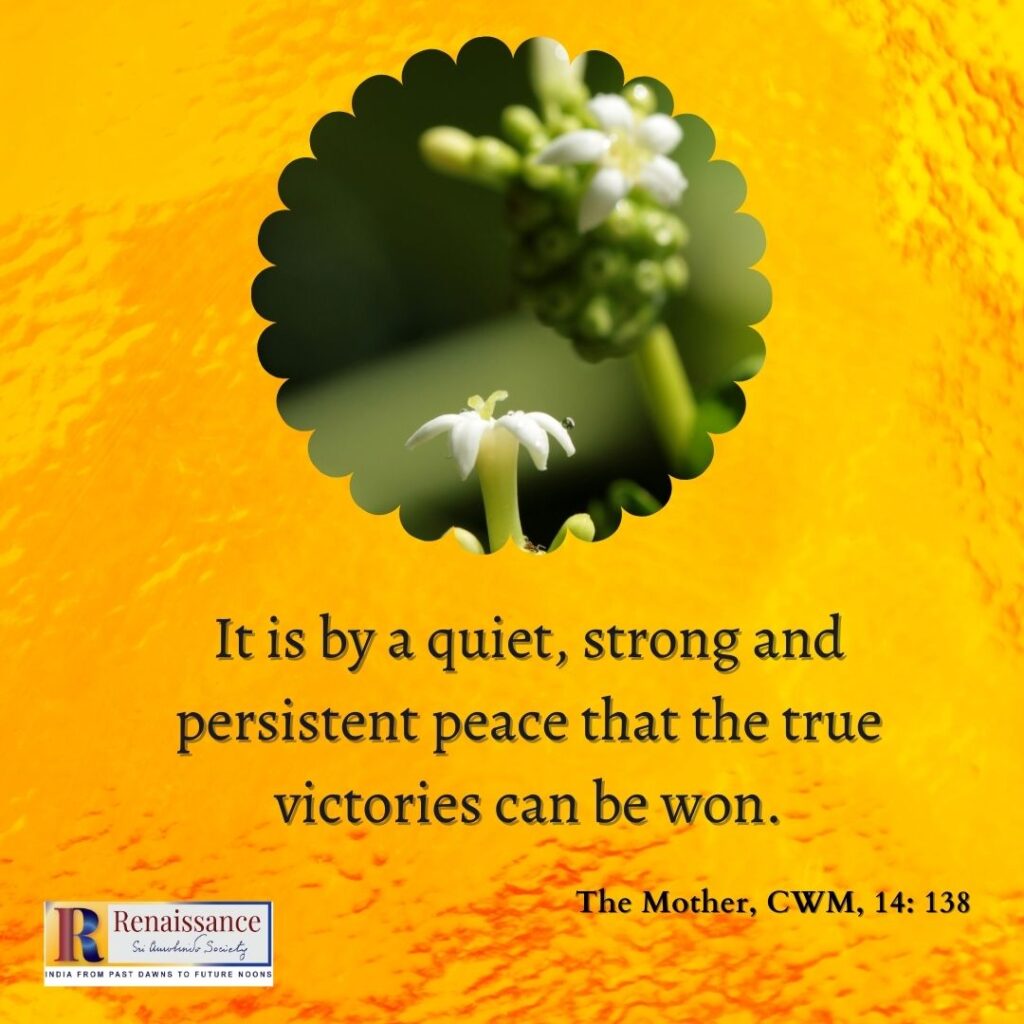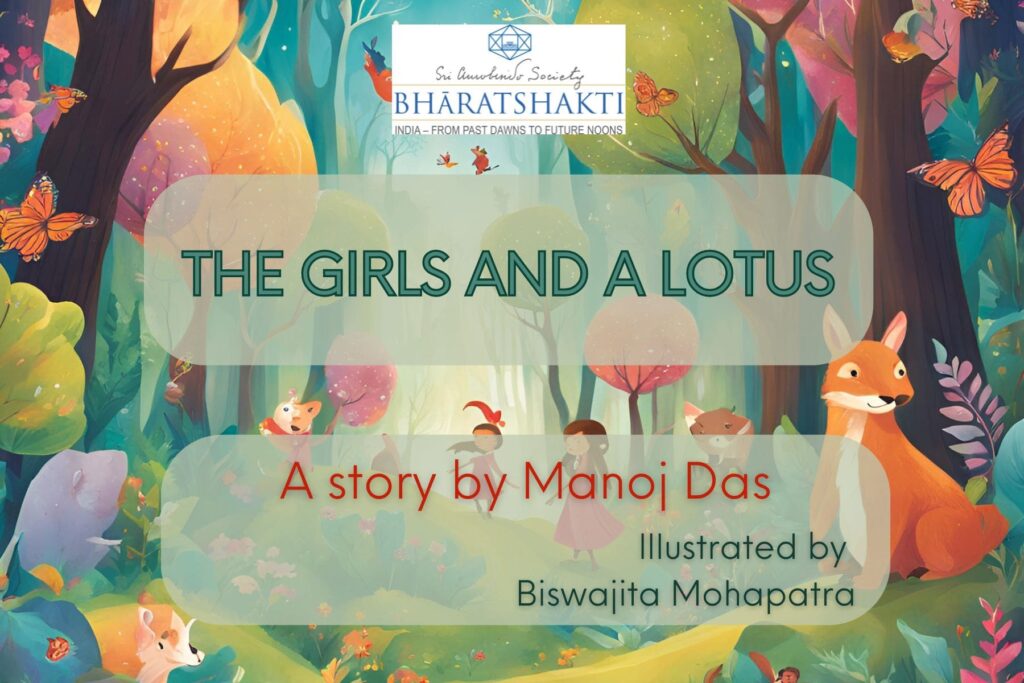Vol. III, Issue 7
Author: Chitra Kolluru
Editor’s Note: Indian mulberry flower is given the spiritual significance – Peace in the sex center. Building upon this, the author reflects on the indispensability of peace in the lower vital part of the being.

Morinda is the largest genus of the Rubiaceae family and its eleven species are found in India. They are known by many names such as the great Morinda, Indian mulberry, noni, beach mulberry and cheese fruit.
Scientifically known as Morinda Citrifolia, the Indian Mulberry is a fruit bearing tree with its native range extending across Southeast Asia and Australasia. It is a resilient plant, growing across a wide variety of habitats such as tropical climes, drought ridden lands, volcanic terrains, lava strewn coasts etc. In spite of this, the plant bears flowers and fruits all year through, as if making peace with all situations.
Commonly known as the noni berry, the fruit is used for direct consumption, for health drinks, is cooked as a vegetable and is used for dyes. Lately, it has gained in significance commercially and is used for both cosmetic and intrinsic health purposes.
The Mulberry Flower
The Mulberry flower that bears this sweet-pungent tasting fruit is a small and placid white flower with typically five distinct petals. The petals are curved and recurved inwards making it look very much like a star. Each flower emerges from a bulb, and these grow off a hard rounded base.
As a child, I grew up in a small hill station town named Sunabeda, which amongst other wild trees was dense with mulberry plants. I have spent many a day picking the delicious fruit without paying much attention to the silent flower. I, however, remember thinking in one odd instance that the clump of whites makes them look like Nature’s ready-made bouquet.
Among several flowers symbolising one or another aspect of peace, the mulberry flower also finds a place in the Mother’s list of spiritual significances of flowers.
Mulberry is popular more for its fruit than for its flower. The fruit is unmistakable for its maroon-purple tinge and sweet taste. The Citrifolia flower blooms and as if subtly coexists in peace amidst the tasty and deep purple mulberry fruit and the medicinally and cosmetically significant mulberry leaves. This is probably, why the Mother called it the flower that stands for Peace in the Sex Centre.

The sex centre, a place if not balanced, is high on lower vital impulses such as desire for sex, lust, anger, greed & gluttony. This center is associated with the two lower chakras or centers of the traditional tantric system — the lotus of the abdomen (the Svādhisthana or sacral chakra) which corresponds to the lower vital in Integral Yoga, and the lotus at the end of the spine (the Mulādhara or the root chakra) corresponding to the physical consciousness in Integral Yoga.
The lowest chakra, the mulādhara is the sex centre, Sri Aurobindo writes in a letter (CWSA, Vol. 28, p. 243). He adds that this center “contains many other things, but also it is in its front the support of the sexual movements.” The svādhisthana or sacral chakra is also said to control our creative expression as well as our sexual impulses. But it also controls our lowest vibrations of jealousy, envy and greed.
The mulādhara chakra especially is associated with the earth element and relates to our basic primal needs of survival, stability and support. Overeating, hoarding of materials, greed for money, lust etc. can be seen as the negative expressions or the need for survival.
As I reflect on all this, it makes perfect sense to me that the Mother gave Citrifolia or Indian mulberry flower the spiritual significance of ‘Peace in the Sex Centre.’ She has ascertained that establishing peace in this chakra is indispensable for the beginning of the Yoga.
Peace is one of the twelve qualities that the Mother talks about as essential for the spiritual path.
“Nowhere will you be able to find Peace unless you have peace in your heart”.
~ CWM, Vol. 14, p. 138
Read more Flower-meditations HERE.
Peace and Freedom
The Mother reminds us that peace is not just what we experience in serene environments, which undoubtedly allow us to become silent and sink in the purity. Nor is the peace only about an inner state of mind. When experienced fully, peace is a power and a poise in which the inner being lives, and from where it decides and acts.
From times immemorial in the Indian culture, calling Peace to manifest has been a part of our everyday practice. The invocation of the Shanti Mantra before and after every important work, ritual or yajna has been a prevalent practice.

The three shanti-s are invoked to be free from tāpatraya or The Burning Three — the three kinds of cravings, sufferings or anxieties. These are: ādhibhautika (physical suffering caused by natural forces, environment and surroundings, primarily effecting the physical life of the being); ādhidaivika (mental suffering caused by supernatural forces such as karmic factors); and ādhyātmika (suffering that comes when the individual has a spiritual yearning but is bogged down by the inner demons such as one’s lower nature and its imperfections.)
Sri Aurobindo reminds:
“In the liberation of the soul from the Ignorance, the very first foundation is peace, calm, the silence and quietude of the Eternal and Infinite….”
~ CWSA, Vol. 22, p. 1026
In essence, Peace has been equated to freedom for the soul. When the body, mind and heart are not subject to emotions arising out of the lower vital feelings, binding our impulses, thoughts and actions; we experience Peace. This freedom from bondage and thereby Peace, emerge from a true knowledge that dispels the darkness of ignorance.
Sri Aurobindo has ascertained the importance of a Silent Mind and called it essential to sadhana. He says, “The first thing to do in the sadhana is to get a settled peace and silence in the mind. Otherwise, you may have experiences, but nothing will be permanent. It is in the silent mind that the true consciousness can be built.” (CWSA, Vol. 29, pp. 149-150)
Further explaining the nature of Peace, Sri Aurobindo adds,
“Peace is more positive than calm—there can be a negative calm which is merely an absence of disturbance or trouble, but peace is always something positive bringing not merely a release as calm does but a certain happiness or Ananda of itself. There is also a positive calm, something that stands firm against all things that seek to trouble, not thin and neutral like the negative calm, but strong and massive.
~ CWSA, Vol. 29, p. 148
From Regret to Peace
Undoubtedly peace and calm are fundamental to all progress in inner and outer life. As a mother of two children — a toddler and a teenager, and having worked in the competitive corporate set up for years now, I am faced with daily situations that challenge the seat of Peace in my heart and I sometimes struggle to establish its reign in me. Passion and an outcome-based effort take over. This sometimes leads to a feeling of regret.
Regret or achievement stemming from passionate action sometimes leads to anger, jealousy, fear, despair, even excitement and exaltation as the case may be. The impulses of lower vital begins to take over.
When I read of the Mahashakti and Her various aspects, forms and powers that run the universe and beyond, I find even this feeling of regret highly egoistic. It is as if I believed my effort was mine alone and that I am somehow separate from the Divine that runs and rules and transcends all.
Can I replace regret with Peace and a silent effort offered to the Mother? At such times I am reminded of the Mother’s calming words that come to my rescue:
Do not get agitated.
~ CWM, Vol. 14, p. 137
Keep quiet and everything will be all right.
Love and blessings.
~ Design: Beloo Mehra



